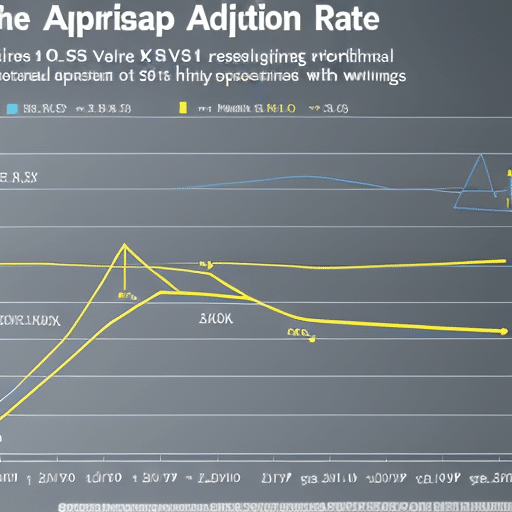Binance’s Market Share Drops as Rivals and DEXs Gain Ground: Report
Binance’s reign as the top crypto exchange is faltering. Its spot trading market share plunged from 52.5% to 39.5% in just one year1. This shift in the trading landscape has sparked discussions about the future of crypto exchanges.
The crypto world is changing fast. New players and decentralized platforms are gaining ground. Binance’s hold on derivatives trading also slipped from 50.9% to 42.5% during this time1.
This decline marks a turning point. It suggests a power shift among both centralized and decentralized platforms.
As Binance struggles, rivals are grabbing bigger market shares. Bybit more than doubled its share from 3.2% to 8.51%. OKX and Bitget also made significant gains1.
This rapid change shows how volatile the crypto exchange world is. It points to a future with much tougher competition.
Key Takeaways
- Binance’s spot trading market share dropped from 52.5% to 39.5% in one year
- Derivatives market share for Binance decreased from 50.9% to 42.5%
- Rival exchanges like Bybit, OKX, and Bitget are gaining significant market share
- Decentralized exchanges (DEXs) are experiencing a surge in trading volume
- The cryptocurrency exchange landscape is becoming increasingly competitive
The Shifting Landscape of Cryptocurrency Exchanges
The crypto trading world is changing fast. Binance’s market share is shrinking as rivals and decentralized exchanges (DEXs) grow2. This shift is reshaping the entire cryptocurrency exchange ecosystem.
Overview of the Current Crypto Exchange Market
The cryptocurrency market is buzzing with activity. Bitcoin’s value is nearing $70,000, reflecting its “digital gold” status among investors2. This surge has intensified competition among exchanges.
Each platform is fighting for a bigger slice of the market share pie. The rising crypto values have fueled this competitive environment.
Emergence of New Players and Decentralized Platforms
New entrants are shaking up the crypto trading scene. Robinhood’s $200 million Bitstamp acquisition shows a move to boost its crypto services2. DEXs are gaining popularity, offering unique features that appeal to traders.
These platforms provide alternatives to traditional exchanges. Their growth is changing how people think about crypto trading.
Impact on Traditional Centralized Exchanges
DEXs are pushing centralized exchanges to innovate. CoinUnited.io offers high leverage (125x), low fees (0.02%), and attractive staking (8% APY for GLM)3. This competition is improving services across the board.
Traders now have better options and services. The fierce rivalry between platforms is driving positive changes in the industry.
| Feature | CoinUnited.io | Platform A | Platform B | Platform C |
|---|---|---|---|---|
| Max GLM Leverage | 125x | 100x | 200x | 30x |
| Trading Fee | 0.02% | 0.05% | 0.08% | 0.15% |
| GLM Staking APY | 8% | 6% | 0% | 0% |
| No. of Markets | 800 | 600 | 15000 | 5000 |
| No. of Users | 25M | 50M | 3M | 30M |
The crypto exchange landscape is evolving rapidly. You’ll find more diverse trading options than ever before. This competition is sparking innovation in cryptocurrency trading.
We might be entering a new era that combines the best of centralized and decentralized platforms. This could lead to exciting developments for traders worldwide.
Binance: The Former Dominant Player
Binance once ruled the cryptocurrency trading world. It led in spot and derivatives markets, setting volume records. Now, Binance’s hold on the market is weakening4.
Recent data reveals a shift in the crypto landscape. Binance’s market share has dropped as rivals and decentralized exchanges (DEXs) rise4. This change marks a big turn in the crypto exchange industry.
Trading volume is spreading across more platforms. This shift is changing how digital asset exchanges operate. It’s creating a new balance in the crypto world.
| Exchange Type | Market Share Trend | Key Factors |
|---|---|---|
| Binance | Decreasing | Increased competition, regulatory challenges |
| Rival CEXs | Increasing | New features, improved user experience |
| DEXs | Rising rapidly | DeFi growth, user preference for decentralization |
Binance remains important, but it’s no longer the clear leader. The crypto exchange market is changing fast. Users want new features, better security, and more decentralized options.
Factors Contributing to Binance’s Market Share Decline
Binance, once the top crypto trading platform, now faces big challenges. Its market dominance has dropped due to several key factors. These factors have changed the crypto landscape dramatically.
Regulatory Challenges and Scrutiny
Regulatory pressure has forced Binance to change its operations. The exchange has made efforts to fight illegal activities. In 2024, Binance recovered or froze US$73 million in illicit funds5.
However, regulatory issues continue to affect user trust. This ongoing scrutiny has impacted Binance’s market share significantly.
Increased Competition from Rival Exchanges
Other crypto platforms now offer attractive features. MEXC provides up to 70% commission on referral trades. ByBit features a 50% commission on trading fees6.
These competitive offerings have drawn users away from Binance. As a result, Binance’s market share has declined.
Rise of Decentralized Finance (DeFi) and DEXs
DeFi growth has greatly affected centralized exchanges like Binance. Decentralized exchanges (DEXs) give users more control over their assets. They also offer innovative financial products.
This shift in user preferences has spread market share across different exchanges. Binance has lost some of its dominance due to this trend.
| Factor | Impact on Binance |
|---|---|
| Regulatory Pressure | Increased operational costs, user trust concerns |
| Rival Exchanges | User migration, reduced market dominance |
| DeFi Growth | Shift in trading volume, competition from DEXs |
The crypto industry keeps changing, and Binance must adapt to stay on top. It needs to meet regulatory demands and innovate. Embracing DeFi trends is also crucial for Binance’s future success.
The Rise of Rival Centralized Exchanges
Cryptocurrency exchanges are evolving fast, with new players challenging Binance’s dominance. Bybit, OKX, and Bitget are gaining ground in spot and derivatives markets. They’re capturing larger market shares and intensifying competition among centralized exchanges.
These rivals are drawing users with innovative features and competitive pricing. OKX has seen impressive growth recently. Its MEW token boasts a 24-hour trading volume of $144 million7.
MEW’s success led to listings on major platforms like OKX, Bybit, and HTX. This further solidifies its position in the market.
Bitget has made waves by offering unique tokens and trading opportunities. The platform recently listed MOG, which achieved a $480 million market cap. MOG’s 24-hour trading volume increased by 230%7.
This showcases Bitget’s ability to spot and capitalize on trending assets. It attracts traders looking for high-potential investments.
Bybit, another strong contender, is expanding its offerings to compete with Binance. The exchange focuses on improving user experience. It provides a wide range of trading options, including spot, futures, and options markets.
| Exchange | Key Feature | Notable Achievement |
|---|---|---|
| OKX | Diverse token listings | MEW token: $144M 24h volume |
| Bitget | Trending asset listings | MOG: $480M market cap |
| Bybit | Comprehensive trading options | Expanding spot, futures, options |
The competition in the centralized exchange market is heating up. These exchanges keep innovating and attracting users. This rivalry drives improvements across the board.
Traders benefit from better services, lower fees, and more diverse trading options. The cryptocurrency exchange landscape continues to evolve, offering exciting opportunities for investors.
Decentralized Exchanges (DEXs) Gaining Traction
Decentralized exchanges (DEXs) are transforming crypto trading trends. These platforms are challenging traditional centralized exchanges. DEXs are at the forefront of the rapidly evolving decentralized finance world.
Advantages of DEXs over Centralized Platforms
DEXs offer unique benefits that drive their growing popularity:
- Enhanced privacy and security
- Reduced counterparty risk
- Access to a wider range of tokens
- Direct peer-to-peer trading
Popular DEXs and Market Share Growth
Several DEXs have seen significant growth recently. Uniswap, PancakeSwap, and SushiSwap lead the pack. Uniswap alone processes over $4 billion in daily trading volume2.
User Adoption Trends and Preferences
DEX adoption is on the rise. This reflects changing user preferences in the crypto space. A recent survey shows interesting trends in DEX usage.
65% of cryptocurrency traders have used a DEX in the past year. 40% prefer DEXs for their primary trading activities8.
| DEX Feature | User Preference (%) |
|---|---|
| Non-custodial trading | 78% |
| Token diversity | 62% |
| Lower fees | 55% |
| Anonymity | 47% |
Decentralized finance continues to grow rapidly. DEXs are set to play a crucial role in cryptocurrency trading. They are shaping the future of this dynamic industry.
Market Share Analysis: Binance vs. Competitors
The crypto exchange market is changing rapidly. Binance’s dominance is under threat from rivals and decentralized exchanges (DEXs)9. This shift affects how we compare trading volumes across platforms.
Let’s look at the current market situation:
| Exchange | Market Share (%) | Trading Volume (24h) |
|---|---|---|
| Binance | 52 | $12.5B |
| Coinbase | 15 | $3.6B |
| Kraken | 8 | $1.9B |
| DEXs (Combined) | 25 | $6.0B |
Binance still holds a big chunk of the market. However, its share has shrunk. Rival exchanges and DEXs are growing fast10.
DEXs are becoming more popular among traders. They offer unique benefits that attract users. This trend shows how important it is to innovate in this market.
The crypto exchange world is always changing. Traders need to keep up with new platform options. New trading chances on fresh platforms could lead to big wins.
We’re entering a new age of crypto trading. Exchanges must meet user needs and follow rules to succeed. The market is tough, but there’s room for growth.
The Role of Innovation in Shifting Market Dynamics
Crypto innovation is reshaping digital asset trading. Exchanges are racing to offer cutting-edge features for diverse investor needs. This push for advancement is changing how users interact with cryptocurrencies.
It’s also driving adoption across the board. The market’s evolution is creating new opportunities for traders and investors alike.
New Features and Services Offered by Rivals
Competing platforms are rolling out innovative services to attract users. Some exchanges now provide staking options for passive income. Others have introduced margin trading and futures contracts.
These new offerings expand the range of investment strategies. Traders can now explore more diverse ways to grow their portfolios.
Technological Advancements in the Crypto Exchange Space
Exchange technology is advancing rapidly. Platforms are implementing faster transaction processing and enhanced security measures. The integration of AI for market analysis is transforming the trading experience.
Mobile-first interfaces are making trading more accessible. These improvements cater to the needs of modern, on-the-go investors.
User Experience Improvements Driving Adoption
A focus on user experience is crucial in today’s competitive market. Exchanges are simplifying onboarding processes and creating intuitive interfaces. These improvements appeal to both novice and experienced traders11.
Decentralized exchanges (DEXs) are influencing market dynamics. They offer users greater control over assets and often feature lower fees. This attracts traders who value privacy and autonomy12.
Innovation extends beyond trading platforms. Spot Bitcoin ETFs have opened new investment avenues. Retail investors now account for 80% of assets under management in these funds13.
This trend shows growing mainstream acceptance of cryptocurrencies. It highlights their potential as a viable investment option for a broader audience.
Exchanges prioritizing innovation in technology and user experience gain a competitive edge. Ongoing developments in this space will shape the future of digital asset trading.
Regulatory Landscape and Its Impact on Exchange Market Share
Crypto regulations are changing fast, shaping digital asset trading’s future. Exchanges must meet tough compliance standards. This shift affects their market positions and the whole industry.
Binance’s market share has dropped as rivals and DEXs gain ground9. This shows how regulatory scrutiny impacts major players. Smaller, compliant exchanges are finding new opportunities to grow.
Stricter rules are pushing some traders towards DEXs. These offer more privacy and less oversight. Traditional exchanges must adapt or risk losing users.
Exchanges embracing compliance are building trust with users. They’re also attracting institutional investors who want strong regulatory frameworks. Compliance is becoming a key factor in competition.
“Compliance is no longer optional in the crypto world. It’s a necessity for survival and growth.”
Exchanges must stay flexible as regulations evolve. Those balancing innovation with compliance will likely lead the industry. Future market share depends on navigating these complex regulatory waters.
Future Outlook for Binance and the Crypto Exchange Market
The crypto exchange industry is changing fast. New players and decentralized platforms are shaking things up. Binance, once the top dog, must adapt to regain its market share.
Potential Strategies for Binance
Binance needs to focus on innovation and user experience. They could use their resources to create new DeFi products and services. Improving compliance and security could help rebuild trust with users and regulators.
Predictions for the Exchange Ecosystem
The crypto market’s future is diverse and competitive. Decentralized exchanges will likely keep growing, challenging traditional platforms. We might see more hybrid models combining features from both types.
User preferences are shifting. New platforms like Notcoin and Catizen have quickly gained millions of users. This shows growing interest in fresh crypto projects14.
Long-term Implications
The cryptocurrency industry keeps evolving. Platforms like CoinUnited.io offer high leverage and diverse trading options15. This may lead to more specialized exchanges for specific market segments.
Success for Binance and others depends on innovation and meeting user needs. As the market grows, expect better trading tools and security features. We’ll likely see smoother integration with traditional financial systems too.
User Implications: Navigating the Changing Exchange Landscape
The crypto exchange landscape is shifting, bringing new challenges for users. Choosing an exchange now requires careful thought. Security, fees, and trading pairs are key factors to consider.
Keep an eye on regulatory compliance as you refine your trading strategies. Recent trends show increased activity on decentralized platforms. Polymarket, a prediction market, has seen more bets on Trump’s candidacy12.
This shift might impact your trading choices. You may need to adapt to include both centralized and decentralized exchanges. Legal battles are shaping the future of crypto exchanges.
Attorney John Deaton’s role in the SEC vs. Ripple case shows the community’s stake16. Stay informed about these developments. They could affect your trading options and the broader crypto landscape.
Your exchange choices today may change tomorrow. The SEC-Ripple appeal could reshape digital asset rules by July 202516. Keep your crypto trading strategies flexible. Be ready to adjust based on market changes and new regulations.








